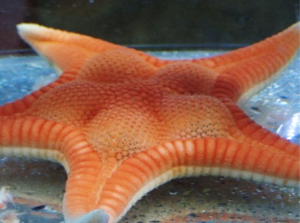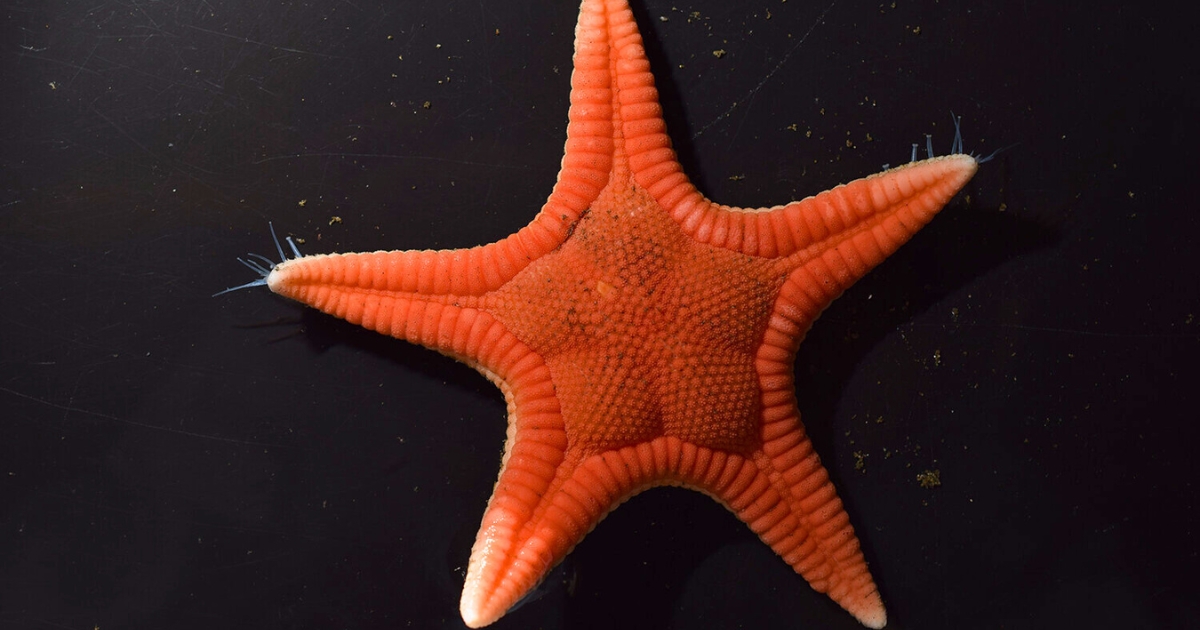Japanese researchers have discovered a new species of starfish from the Pseudarchasteridae family, the first such discovery in 51 years. This groundbreaking discovery was made possible through collaboration between researchers from the University of Tokyo’s Misaki Marine Biological Station, Enoshima Aquarium, Fukushima Marine Science Museum, and Yamaguchi Prefectural Fisheries Research Center.
The new starfish species has been given the scientific name “Paragonaster hoeimaruae” and the Japanese name “Hoei Miyabi Momiji Starfish.” It belongs to the Pseudarchasteridae family and has a beautifully symmetrical red body. The body size is approximately 10 centimeters with five arms.
This research was published in the “Journal of Natural History,” making a significant contribution to the field of marine biology.

Starfish are classified as echinoderms. This word originates from ancient Greek, meaning “hedgehog skin.” While there are many types of starfish, this particular starfish is especially adapted to life in sandy and muddy waters, and researchers are keen to learn more about this characteristic. Credit: I. Kobayashi
The Pseudarchasteridae family is characterized by a flattened body bordered by block-like bones and sucker-tipped tube feet. Previously thought to be part of the Goniasteridae family, recent genetic studies have revealed it to be a separate taxonomic group. This discovery prompts a reconsideration of marine organism classification and plays an important role in more accurately understanding the process of evolution.
From 2021 to 2023, the research team collected various species from across Japan. Specimens were gathered from shrimp and crab traps used by fishermen in Hokkaido and Shizuoka prefectures, as well as through beam trawl surveys (a method of dragging a large net across the seafloor) conducted by Yamaguchi Prefecture’s fisheries research vessel. The name “Hoei” in the new starfish’s name comes from the fishing vessel “Hoei-maru,” which first collected the specimen. This collaborative research method demonstrates the importance of cooperation between scientific research and local industries.
In addition to the new species discovery, the research team also reported new habitats for three species of the Pseudarchasteridae family. Of particular note is the discovery of the “Gephyreaster” genus in Rausu, Hokkaido. This genus had previously only been reported from the west coast of America to the Bering Sea, making this the first discovery in Japan. The Gephyreaster genus is a surprisingly large starfish with a diameter of about 30 centimeters. This discovery challenges conventional understanding of marine organism distribution and migration patterns and may provide important clues for studying the impact of climate change on marine ecosystems.
Itaru Kobayashi, an academic specialist at the University of Tokyo’s Misaki Marine Biological Station, states: “While about 250 species of starfish live around Japan, the fact that such a large species had been overlooked demonstrates how incomplete our understanding of marine biodiversity is. This discovery clearly shows that there are still significant gaps in our knowledge of marine ecosystems.”
With this discovery, the number of Pseudarchasteridae species in Japan has been updated to six, but researchers believe there is a possibility of discovering even more species in the future. This reaffirms the richness of marine biodiversity and emphasizes the importance of protecting unknown species.
The Paxillosida order, to which the Pseudarchasteridae family belongs, is a specialized group adapted to sandy and muddy environments, but much remains unknown about its adaptive evolutionary history. This research is expected to provide a foundation for revealing new aspects of starfish evolution. In particular, elucidating the mechanisms of adaptation to sandy and muddy environments may provide important insights into understanding marine organisms’ environmental adaptability and predicting survival strategies under climate change.
This research demonstrates the importance of cooperation among fishery professionals, aquariums, universities, and other research institutions in better understanding marine biodiversity. It proves that collaboration among people with different expertise and experiences can lead to such groundbreaking discoveries and may serve as a model case for future marine research.
This discovery reminds us of the ongoing importance of marine research. While marine environments face various threats such as climate change and ocean pollution, the discovery of new species in such circumstances suggests that there is still much unknown life in the oceans. This may provide scientific evidence supporting the importance of marine protection policies, such as establishing marine protected areas and developing sustainable fishing methods.
This research also suggests the importance of each individual taking an interest in and action for marine environmental protection. The discovery of new species illustrates the complexity of marine ecosystems that we still do not fully understand, emphasizing the need for their protection. It also suggests the importance of marine organism observation and reporting by the general public, expanding the possibilities of citizen science.
Summary
This discovery reaffirms the appeal and importance of science. New discoveries deepen our understanding of the world and stimulate our desire for further exploration. Many mysteries remain in the oceans, and the process of unraveling them will continue to provide us with surprise and excitement. At the same time, this research is expected to inspire young scientists and marine biologists, contributing to the future development of marine research.
The discovery of this new starfish species is not just a biological finding, but an important event that has broad implications for our understanding of marine ecosystems, environmental protection, scientific research methodologies, and our relationship with the oceans.
More information: Itaru Kobayashi et al, Pseudarchasteridae (Asteroidea: Paxillosida) in Japanese waters, with description of a new species and range extension of three species, Journal of Natural History (2024). DOI: 10.1080/00222933.2024.2377336
Journal information: Journal of Natural History
Provided by University of Tokyo


